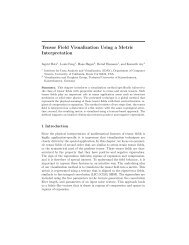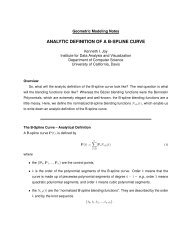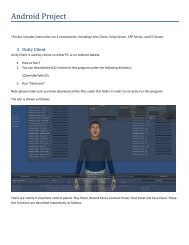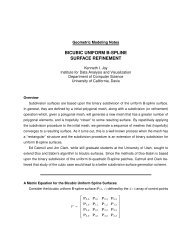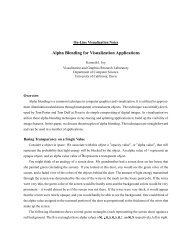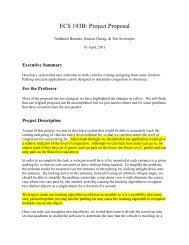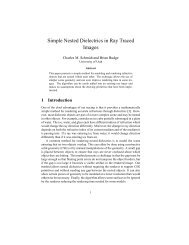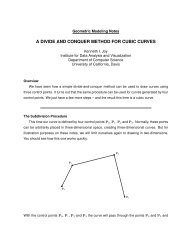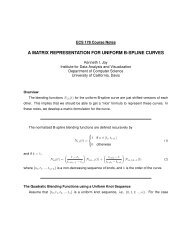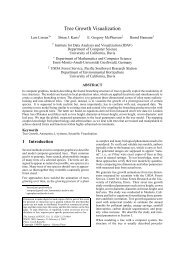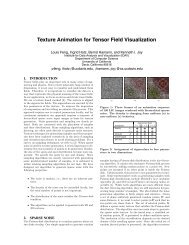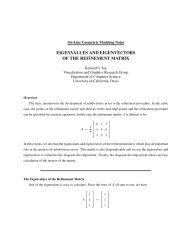14 · Lefohn, Kniss, Strzodka, Sengupta, <strong>and</strong> Owens4.3.1 Address Iterators. Address iterators are an important concept <strong>for</strong> the Glift implementation <strong>for</strong> two reasons.First, address iterators can be efficiently implemented as GPU rasterizer interpolants (i.e., texture coordinates). Second,they are the iterator type supported by AddrTrans components. The concept enables address translators to specifyiteration without having knowledge of physical data.Glift address translators generate a stream of valid virtual addresses <strong>for</strong> a GPU data structure. They abstract thescreen-space geometry used to initiate GPU computation as well as the physical-to-virtual translation required to mapfrom fragment position to the virtual address domain. Glift represents address iterators using vertex data, vertex shadercode <strong>and</strong> parameters, <strong>and</strong> a viewport specification.Note that this design means that modifying a Glift data structure (e.g., inserting or deleting elements) means writingto both the address translator memory <strong>and</strong> the iterator representation. The latter operation requires either render-tovertex-arraysupport or CPU involvement.4.3.2 Element Iterators. Glift element iterators pose several challenges <strong>for</strong> implementation on current GPUs.First, element iterators are a pointer-like abstraction, <strong>and</strong> GPUs do not support pointers. Second, GPU data structuretraversal is usually accomplished with the rasterizer, yet the rasterizer cannot generate true memory addresses.It can only generate N-D indices via texture coordinate interpolation (i.e., address iterators). As such, Glift implementselement iterators by combining an address iterator with a Glift container (either PhysMem or VirtMem). Thelast challenge is the design requires shading language structures that contain a mixture of uni<strong>for</strong>m <strong>and</strong> varyingmembers. This feature has recently only been added to Cg <strong>and</strong> is not yet supported in other languages.4.4 Mapping Glift <strong>Data</strong> into CPU MemoryAll Glift components are designed to support data access on both the CPU <strong>and</strong> GPU. Glift implements this featureby supporting explicit map cpu <strong>and</strong> unmap cpu functionality. Just as with mappable GPU memory like vertexbuffer objects <strong>and</strong> pixel buffer objects, map copies the data into CPU memory while unmap copies data into GPUmemory. The default behavior is to transfer the entire data structure; however, Glift can optionally operate in a paged,lazy-transfer mode where only the required portions of the structure are copied. This mode reduces CPU read/writeefficiency but can greatly reduce the amount of data sent between the CPU <strong>and</strong> GPU.Initial designs attempted to automatically map data to the appropriate processor based on usage. This proved problematic,however, because it is not possible to detect all cases when a GPU-to-CPU or CPU-to-GPU synchronizationis required. For example, this can arise if a user binds a Glift structure to a shader, writes to the CPU mapping ofthe structure, then later re-binds the shader without explicitly re-binding the Glift structure. This is a perfectly legalOpenGL usage pattern, but one in which Glift cannot detect that the structure is now being read by the GPU. To supportthis automatic virtualization, Glift would either have to subsume a much larger portion of the GPU programmingmodel (shader binding, etc.) or be integrated directly into GPU drivers.4.5 Virtualized Range OperationsProviding generic support <strong>for</strong> virtualized range operations (read, write, copy) was one of the toughest challenges inthe design of Glift. The goal is <strong>for</strong> application programmers to be able to easily create new containers that havefull support <strong>for</strong> these operations. The challenge is that the contiguous virtual region over which these operations aredefined often maps to multiple physical regions.Early designs placed this functionality in the VirtMem component. This approach, however, required each datastructure to implement a significant amount of redundant, complex code. Our solution is inspired by a concept fromautomatic parallelization research. In their work to create a parallel STL, Austern et al. describe a range partitionadaptor as an entity that takes a range defined by a begin <strong>and</strong> end iterator <strong>and</strong> breaks it up into subranges which canbe executed in parallel [1996]. Applying this idea to Glift, the generic range operation problem is solved if addresstranslators can translate a virtual range into an ordered sequence of physical ranges.The prototypical usage of this operation is:ACM Transactions on Graphics, Vol. 25, No. 1, January 2006.
Glift: Generic, Efficient, R<strong>and</strong>om-Access GPU <strong>Data</strong> Structures · 15✞vec3i virtOrigin(0), virtSize(1,2,7); // input: origin <strong>and</strong> size of virtual rectangleAddrType::ranges_type ranges; // ouput: corresponding physical rangesaddrTrans.translate_range( virtOrigin, virtSize, ranges );☎<strong>for</strong> (size_t i = 0; i < ranges.size(); ++i) {DoPhysRangeOp( ranges[i].origin, ranges[i].size );}✝// per<strong>for</strong>m operation on rangeswhere DoPhysRangeOp per<strong>for</strong>ms an operation such as read/write/copy across a range of contiguous physical addresses.The generic VirtMem class template now uses this idiom to virtualize all of the range-based memory operation<strong>for</strong> any address translator.While conceptually simple, the design had a profound effect on Glift: address translators are now composable. Thedesign places all of the data structure complexity into the address translator, which in turn means that fully virtualizedcontainers can be constructed by combining simpler structures with little or no new coding.5. CLASSIFICATION OF GPU DATA STRUCTURESThis paper demonstrates the expressiveness of the Glift abstractions in two ways. First, this section characterizes alarge number of existing GPU data structures in terms of Glift concepts. Second, Section 6 introduces novel GPU datastructures <strong>and</strong> two applications not previously demonstrated on the GPU due to the complexity of their data structures.The classification presented in this section identifies common patterns in existing work, showing that many structurescan be built out of a small set of common components. It also illuminates holes in the existing body of work <strong>and</strong>trends.5.1 Analytic ND-to-MD TranslatorsAnalytic ND-to-MD mappings are widely useful in GPU applications in which the dimensionality of the virtual domaindiffers from the dimensionality of the desired memory. Note that some of the structures in Table II use ND-to-MDmappings as part of more complex structures. These translators are O(1) memory complexity, O(1) access complexity,uni<strong>for</strong>m access consistency, GPU or CPU location, a complete mapping, one-to-one, <strong>and</strong> invertible.The mappings are typically implemented in one of two ways. The first <strong>for</strong>m linearizes the N-D space to 1D, thendistributes the the 1D space into M-D. C/C++ compilers <strong>and</strong> Brook support N-D arrays in this manner. The secondapproach is to directly map the N-D space into M-D memory. This is a less general approach but can result in a moreefficient mapping that better preserves M-D spatial locality. For example, this approach is used in the implementationof flat 3D textures [Goodnight et al. 2003; Harris et al. 2003; Lefohn et al. 2003]. Either implementation can beimplemented wholly on the GPU. Lefohn et al. [2005] detail the implementation of both of these mappings <strong>for</strong> currentGPUs. Glift currently provides a generic ND-to-2D address translator called NdTo2dAddrTransGPU.5.2 Page Table TranslatorsMany of the GPU-based sparse or adaptive structures in Table II are based on a page table design. These structures area natural fit <strong>for</strong> GPUs, due to their uni<strong>for</strong>m-grid representation; fast, uni<strong>for</strong>m access; <strong>and</strong> support <strong>for</strong> dynamic updates.Page tables use a coarse, uni<strong>for</strong>m discretization of a virtual address space to map a subset of it to physical memory.Like the page tables used in the virtual memory system of modern operating systems <strong>and</strong> microprocessors, page tabledata structures must efficiently map a block-contiguous, sparsely allocated large virtual address space onto a limitedamount of physical memory [Kilburn et al. 1962; Lefohn et al. 2004].Page table address translators are characterized by O(N) memory complexity, O(1) access complexity, uni<strong>for</strong>maccess consistency, GPU or CPU location, complete or sparse mapping, <strong>and</strong> one-to-one or many-to-one mapping.Page tables are invertible if an inverse page table is also maintained.ACM Transactions on Graphics, Vol. 25, No. 1, January 2006.✆
- Page 6 and 7: 6 · Lefohn, Kniss, Strzodka, Sengu
- Page 8 and 9: 8 · Lefohn, Kniss, Strzodka, Sengu
- Page 10 and 11: 10 · Lefohn, Kniss, Strzodka, Seng
- Page 12 and 13: 12 · Lefohn, Kniss, Strzodka, Seng
- Page 16 and 17: 16 · Lefohn, Kniss, Strzodka, Seng
- Page 18 and 19: 18 · Lefohn, Kniss, Strzodka, Seng
- Page 20 and 21: 20 · Lefohn, Kniss, Strzodka, Seng
- Page 22 and 23: 22 · Lefohn, Kniss, Strzodka, Seng
- Page 24 and 25: 24 · Lefohn, Kniss, Strzodka, Seng
- Page 26 and 27: 26 · Lefohn, Kniss, Strzodka, Seng
- Page 28 and 29: 28 · Lefohn, Kniss, Strzodka, Seng
- Page 30 and 31: 30 · Lefohn, Kniss, Strzodka, Seng
- Page 32 and 33: 32 · Lefohn, Kniss, Strzodka, Seng
- Page 34 and 35: 34 · Lefohn, Kniss, Strzodka, Seng
- Page 36 and 37: 36 · Lefohn, Kniss, Strzodka, Seng



